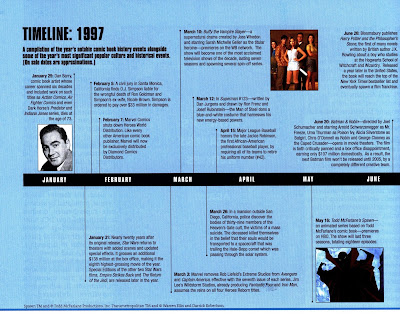The 1990s: 1990 - 1999
by Jason Sacks and Keith Dallas
TooMorrows Publishing, September 2018
My review of the volume for 1965-1969 is here.
My review for the volume for the 1970s is here.
My review for the volume for the 1980s is here.
In the early 1990s, I remember going into Steve Geppi's Comic World in the Woodlawn neighborhood of West Baltimore on a monthly basis. While Comic World was by no means a small store, it was literally overflowing with inventory: racks stuffed full of comic books; piles of comic books stacked up on display tables; cardboard shipping boxes, stuffed with yet more comic books, lying on the floor. At the sales counter, there would be copies of the latest issue of Wizard vying for space with stacks of boxes of superhero trading cards.
It was flabbergasting to see just how much Comic Book Product was contained within that one store.
I would come away with the two or three titles that I was interested in, and a single, powerful thought: who the fuck is buying all this crap ???!!!!!!!!
Who was buying five copies of the polybagged issues of X Force #1 so they could get the complete set of the five trading cards sequestered in each issue ?
Who was buying the special 'Memorial' issue of Superman #75 ('the death of Superman') for $2.50 in order to get not just the comic book, but the exclusive memorial poster, the exclusive mourning armband, the official Daily Planet obituary, and the exclusive Skybox 'Death of Superman' Commemorative trading card ?
Who was buying all 23 Annuals associated with DC comic's 1993 'Bloodlines' crossover ?
Who was buying the comics created by Clive Barker for Marvel's 'Razorline' imprint that same year ?
And even after the Crash, who on earth was buying all the issues in the 'Clone Saga' ?!
Well, in the pages of 'American Comic Book Chronicles: The 1990s' (287 pp, TooMorrows Publishing, September 2018) you will learn how the comic book market underwent an unprecedented expansion in the early 1990s, an expansion fueled in part by speculators who thought that obtaining an issue of Spectacular Spider-Man with a hologrammed cover would, within just a few years of being published, bring them a major return on their investment.
As authors Jason Sacks and Keith Dallas point out, there were indicators and warnings in the first half of 1993 that the giddy boom in comic book sales that marked the early years of the decade (for example, in the Summer of 1990, Marvel printed 2.35 million copies of Spider-Man #1, a record for the industry) was going to come crashing down.
And crash it did. As the Summer of 1993 turned into Fall, the collapse of the trading card market quickly was followed by the collapse of the comic book market. By December, 1993, retailers were struggling to pay their bills, while sitting on thousands of dollars worth of inventory that they would never be able to sell. As Sacks and Dallas point out, in 1994, 40% of the nation's 9,000 comic book retailers went out of business.
While smaller publishers like Eclipse couldn't survive the crash, Marvel comics did, even though in 1995 it angered retailers by forcing them to acquire all Marvel titles through one distributor, Hero's World. But Marvel could only stave off disaster for so long; in December 1996, it filed for bankruptcy.
Throughout the pages of 'American Comic Book Chronicles: The 1990s' Sacks and Dallas ably document the travails and triumphs of the comic book industry. Their history of the era is made all the more readable by the inclusion of all sorts of insider anecdotes; for example, publisher Fantagraphics survived the Crash via strong sales of its porno comics line, Eros Comics. But by 1998, internet porn had so supplanted the market for porno comics that Fantagraphics found itself in economic straits.....
As with the other volumes in this series, as you go through the pages of 'American Comic Book Chronicles: The 1990s' you're going to find yourself noting all sorts of titles that you had never been aware of, and wondering, now, if they are worth investigating.
The book does have some weaknesses (in my opinion). Rather too much attention is paid to the Indie Comics movement and its lead artists / writers (do we really need to know about Too Much Coffee Man or Stuck Rubber Baby ?). Yet, even as coverage is given to the more obscure Indie publishers, Caliber Comics, one of the major Indie publishers of the decade, gets very little mention.
On the whole, however, 'American Comic Book Chronicles: The 1990s' does a good job as an overview of the most tumultuous decade in American comic book history. While it's an expensive book, you can find used (and even new) copies for under $30 at your usual online retailers.
I recommend buying it sooner rather than later, as once the current inventory is gone, the speculators will be advertising their copies on amazon for several hundred dollars each..........




































.jpg)


















